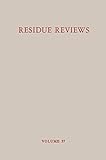Residue reviews: residues of pesticides and other foreign chemicals in foods and feeds [Libro electrónico] / editors: Francis A. Gunther, Jane Davies Gunther
Gunther, Francis A [editor] | Gunther, Jane Davies [editor/a].
Tipo de material: Libro
en línea Series Editor: New York, New York, United States: Springer-Verlag, c1971Descripción: xi, 203 páginas : ilustraciones.ISBN: 9781461584759 (Print); 9781461584735 (Online).Nota de acceso: Disponible para usuarios de ECOSUR con su clave de acceso Nota de bibliografía: Incluye bibliografía e índice: páginas 197-202 Número de sistema: 55418Contenidos:Mostrar
Resumen:
Libro
en línea Series Editor: New York, New York, United States: Springer-Verlag, c1971Descripción: xi, 203 páginas : ilustraciones.ISBN: 9781461584759 (Print); 9781461584735 (Online).Nota de acceso: Disponible para usuarios de ECOSUR con su clave de acceso Nota de bibliografía: Incluye bibliografía e índice: páginas 197-202 Número de sistema: 55418Contenidos:Mostrar
Resumen:| Tipo de ítem | Biblioteca actual | Colección | Signatura | Estado | Fecha de vencimiento | Código de barras |
|---|---|---|---|---|---|---|
| Libros | Biblioteca Electrónica Recursos en línea (RE) | Acervo General | Recurso digital | ECO400554181189 |
Incluye bibliografía e índice: páginas 197-202
1. Chemical and physical properties of phosphamidon.. 2. Analytical methods for phosphamidon.. 3. Formulations of phosphamidon.. 4. The metabolism of phosphamidon in plants and animals.. 5. Toxicology of phosphamidon.. 6. The behavior of phosphamidon in plants.. 7. Phosphamidon residue methods.. 8. Rate of degradation of phosphamidon and residue values.. 9. Toxic effects of phosphamidon to insects and mites.. 10. Experimental and practical experience with phosphamidon in the field.. Subject Index
Disponible para usuarios de ECOSUR con su clave de acceso
More and more biologists, chemists, pharmacologists, toxicologists, gov ernmental agencies, and "food control" (regulatory) ofncials around the world are nnding it increasingly difncult to keep abreast of the technical literature in the pesticide neid; indeed, many libraries do not have even a small proportion of the journals and other sources that now regularly contain research, development, and application information ab out all aspects of modern chemical pest control. As a result, a very large number of requests has come to "Residue Reviews" to publish detailed digests of information on single pesticide chemicals so that the interested person in any part of the world could easily be brought up to date with all available important in formation without having to search probably several hundred literature sources, many of them obscure or simply not available except in very large libraries. The service and convenience rendered the readership by such a series of volumes on major individual pesticide chemicals would therefore be considerable. Type and scope of coverage in this series of single-pesticide volumes will oE course vary with available information. The coverage should be as com plete as possible, however, to be of maximum value to all interested indi vi duals, industries, research institutions, and governmental agencies con cerned with the continuing production of an adequately large yet safe food supply for the world. Among the topics bracketed for a single pesticide should ideally be: I. Introduction 11. eng
Disponible en línea
Disponible en formato PDF
Subscripción a ELSEVIER 26 de diciembre del 2013
